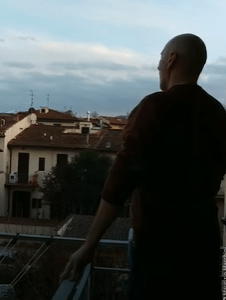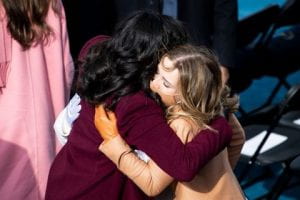By: Camille Davis
Forgoing the Visage in Lieu of the Soul: The Way in Which Covid-19 May Change our Post-Corona Aesthetics and Attitudes



Top: The Cover of Vogue and the Metropolitan Museum of Art Costume Institute’s 2020 Commemorative Edition. Bottom: The Cover of Kimberly Chrisman-Campbell’s Worn on this Day: The Clothes that Made History, published in 2019. Middle: A 1943 Vogue graphic explaining the importance of sacrifices to its readers during World War II.
In a pre-Covid-19 world, the first Monday of May would inextricably be known as the day of the Metropolitan Museum of Art’s Met Gala. This mammoth fundraiser highlights the spring exhibition of the Met’s Costume Institute, and it brings together the biggest names in the art, fashion, entertainment, and athletic worlds. This year, the Met Gala, like so many other mainstay components of Western, pre-Corona life is indefinitely postponed. The Met’s need to reschedule is one of many reminders of the capriciousness of the time, and it is a reminder of what little control anyone has over something that felt like an indelible component of human control and human strength in the current age — namely the ability to control one’s personal image.
Yes, the Met Gala is an event that highlights the role of clothing and costumes as expositors of major historical moments and eras. But it also does something else that largely may have gone unnoticed until now: It champions a mild form of humanism. It glorifies the human predilection and practice of using clothing as a means of explaining one’s personal values, aspirations, and preferences to the world. It celebrates the role of clothing throughout history as a mechanism for human beings to communicate — and control — how they are seen and evaluated.
Such a power — a power to control perception — has historically been described as necessary, appropriate, and possibly an inherent right of one’s humanity. Think of Fredrick Douglass’ 19th century advocation of photography as a means for African Americans to present themselves as people of dignity in order to combat racial caricatures and stereotypes rooted in slavery. Or what about the practice of 18th and 19th century Native Americans who masterfully blended Euro-centric attire with their own indigenous styles to convey individuality at a time when the U.S. imperial ambitions relegated and condensed all indigenous people to the amorphous, ambiguous, non-specific “Indian”?

Frederick Douglass. Courtesy of Biography.com

Payouska (Pawhuska), Chief of the Great Osage. Charles Balthazar Julien Févret de Saint-Mémin. Silhouette, 1804. National Portrait Gallery
Consider the role of long hair and beards in the 1960s and 1970s as a visual component of the anti-establishment, youth quake. Or think of the practice of 17th and 18th century European aristocrats and American gentry of wearing powdered whigs to convey wealth, power, and physical prowess.

Woodstock, 1969. Courtesy of the NYTimes.com

King George III. Allan Ramsay. Oil on canvas. 1761-1762
58 in. x 42 in. National Portrait Gallery
The history of human adornment and self-presentation provide extraordinary physical evidence of the ways in which people attempt to advocate for themselves and their interests over time. And in the pre-Covid, 21st century, the desire — and the ability — to tailor perceptions may have been higher than at any other time in human history.
But yet, life abruptly shifted.
The institutions, mechanisms, and structures in place that normally provide the materials for self-imaging are now hampered by the pandemic crisis of Covid-19. The fashion houses, the salons, the barber shops, the spas, and the boutiques are no longer readily available. There is no way to maintain one’s “normal” visage and style for public consumption at this moment. From most reports, this will be the case for the foreseeable future. And perhaps that is a good thing.
Although possessing agency over one’s personal visage is a necessary and fundamental part of living in a free society, it can create a new bondage of its own. The 21st century’s ubiquitous use of social media insinuated an idea of perpetual camera-readiness across the “developed” world that no one truly could ever maintain — before, during, or after — Corona. Instead of the image operating as a representation of a human being, somehow it became a replacement for the human being himself. Looking good became a substitution for being good. Perhaps now, the image has an opportunity to be relegated to its place in order to give the soul a chance to reclaim its rightful position within the human psyche.
Think of “The Greatest Generation”
In March, Princeton University’s Meg Jacobs recalled to CNN the “soul work” of the World War II generation that parallels and exceeds our own. While discussing the sacrifice of those in the armed services who fought across multiple battle fronts and the collective manufacturing efforts of men and women who braved the dangers and excesses of factory life to make supplies for those who fought, Jacobs mentioned some of the aesthetic and sartorial sacrifices required of the time. She recounted that some of the prevailing wisdom was to “Repair a shirt rather than buy a new one; paint on nylons instead of wearing the real thing, [and] go without cuffs on your pants.”
Jacobs explained that women were encouraged to wear pants instead of skirts to preserve fabric and to refrain from nylon stockings so that nylon could be used for parachutes. And although it would be reductive and historically inaccurate to romanticize the American society and politics of the 1930s and 1940s — there were plenty of political, social, and moral demons that needed expulsion — it is true that the military success of American troops and the subsequent economic success that helped underpin the “American century” resulted from a collective willingness to adjust to the demands of that day’s crises.
Jacob’s example is a timely reminder of the power that emanates from communal sacrifice.

Vogue, September 1943 Cover
Heroism in our Time

Christine McCarthy, a nurse at Massachusetts General Hospital in Boston on Apr. 2.
Photo Courtesy of Erin Clark—Boston Globe/Getty Images and Time.com
In response to Covid-19, there is a plethora of sacrificial beauty to behold — and to draw inspiration from — in our time, as well. There are the healthcare workers, first responders, food producers/distributors, and essential workers all over the world. And there are the arias from Italian balconies, the poignant sounds from #togetherathome and #homefest concerts, and the optimism emanating from virtually syncronized glee clubs. What of Andrea Bocelli’s hair-raising concert on Easter and the Metropolitan Opera’s concert on April 25th? Think of those quietly serving neighbors and friends without humble-bragging on public platforms. And oh yes – there are the countless fashion houses that are manufacturing medical supplies and hand sanitizer or providing funds for Covid-19 relief. There are extraordinary opportunities to exhibit generosity of spirit during this uncertain and worrisome time.

Photo Courtesy of NYtimes.com

Italian Tenor Maurizio Marchini’s rendition of ‘Nessun Dorma’, translated ‘None shall sleep’ from his balcony in March went viral. Many grew particular inspiration from Marchini picking up his small son as he sang the words ‘Vincerò!’ translated ‘I will be victorious.’ Photo Courtesy of Youtube.com
When life resumes some of its normality, there will be plenty masters of aesthetics to lead the way with beauty and with “soul.” Pierpaolo Piccioli, the Creative Director of Valentino is publicly discussing the need for using women of color as muses for European fashion houses. He has done so and continues to do so in his work. Harvard Business School alum Nadia Boujarwah sustains the brand she co-created called Dia&Co, a direct-to-consumer clothing line for women who struggle to find plus-size clothing. Additionally, there is Dallas based social organizer, NeAndre Broussard, who creates photo exhibitions of black men in suits to challenge and change Western misconceptions of black masculinity. And of course, Vogue and the Council of Fashion Designers of America (CFDA) continue to raise money for charitable causes in need of funding and exposure.

Adut Akech, South-Sudanese/Australian model who is the preeminent face of Maison Valentino. She is wearing a dress from the fashion house in the photo by Johnny Dufort. Photo Courtesy of The New York Times Style Magazine.
Most assuredly, the institutions that make us “camera ready” and “picture perfect” will again have their day in the sun. And so will we, the consumers. But until that day comes, may we join with those who are forgoing their image for the benefit of their — and others’ — souls. And may we become a bit more accepting and loving of our pandemic visages — and sacrificial attitudes — even after we overcome the pandemic itself.
Wouldn’t that make for such a beautiful world?



























